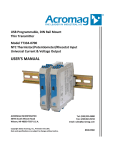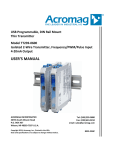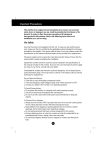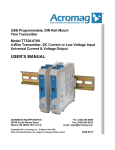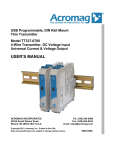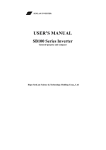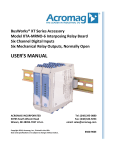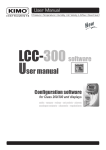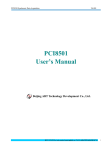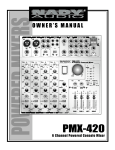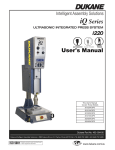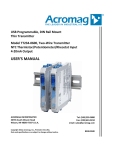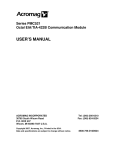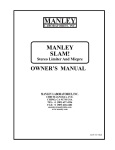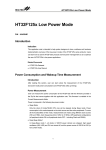Download 8500948 TT339-0700 User`s Manual
Transcript
USB Programmable, DIN Rail Mount Thin Transmitter Model TT339-0700 Isolated 4-Wire Transmitter, Frequency/PWM/Pulse Input Universal Current & Voltage Output USER’S MANUAL ACROMAG INCORPORATED 30765 South Wixom Road Wixom, MI 48393-7037 U.S.A. Copyright 2014, Acromag, Inc., Printed in the USA. Data and specifications are subject to change without notice. Tel: (248) 295-0880 Fax: (248) 624-9234 email: [email protected] 8500-948G Model TT339-0700 4-Wire Isolated Frequency Transmitter w/USB Table of Contents GETTING STARTED DESCRIPTION............................................................................................ 4 Key Features ........................................................................................................................4 Application ..........................................................................................................................4 Mechanical Dimensions .......................................................................................................5 DIN Rail Mounting & Removal ..............................................................................................5 ELECTRICAL CONNECTIONS ....................................................................... 6 Sensor Input Connections ....................................................................................................7 Output Connections .............................................................................................................9 Power Connections ............................................................................................................ 10 Optional Bus & Redundant Power Connections .................................................................. 11 Earth Ground Connections ................................................................................................. 12 USB Connections................................................................................................................ 13 CONFIGURATION SOFTWARE.................................................................. 14 Quick Overview ................................................................................................................. 14 OPERATION STEP-BY-STEP ...................................................................... 16 Connections....................................................................................................................... 16 Configuration..................................................................................................................... 18 Calibration (Optional) ........................................................................................................ 22 BLOCK DIAGRAM .................................................................................... 23 How It Works ..................................................................................................................... 23 Flow Chart ......................................................................................................................... 24 Measurement Techniques .................................................................................................. 25 Acromag, Inc. Tel: 248-295-0880 [2] -2- http://www.acromag.com http://www.acromag.com Model TT339-0700 4-Wire Isolated Frequency Transmitter w/USB TROUBLESHOOTING ............................................................................... 25 Diagnostics Table ............................................................................................................... 25 Service & Repair Assistance ............................................................................................... 26 ACCESSORIES.......................................................................................... 27 Software Interface Package................................................................................................ 27 USB Isolator ....................................................................................................................... 27 USB A-B Cable .................................................................................................................... 27 USB A-mini B Cable ............................................................................................................ 27 SPECIFICATIONS ..................................................................................... 28 Model Number .................................................................................................................. 28 Input ................................................................................................................................. 28 Output............................................................................................................................... 30 USB Interface ..................................................................................................................... 32 Enclosure & Physical .......................................................................................................... 33 Environmental ................................................................................................................... 33 Agency Approvals .............................................................................................................. 34 Reliability Prediction .......................................................................................................... 34 Configuration Controls ....................................................................................................... 34 REVISION HISTORY ................................................................................. 35 All trademarks are the property of their respective owners. IMPORTANT SAFETY CONSIDERATIONS You must consider the possible negative effects of power, wiring, component, sensor, or software failure in the design of any type of control or monitoring system. This is very important where property loss or human life is involved. It is important that you perform satisfactory overall system design and it is agreed between you and Acromag, that this is your responsibility. The information of this manual may change without notice. Acromag makes no warranty of any kind with regard to this material, including, but not limited to, the implied warranties of merchantability and fitness for a particular purpose. Further, Acromag assumes no responsibility for any errors that may appear in this manual and makes no commitment to update, or keep current, the information contained in this manual. No part of this manual may be copied or reproduced in any form without the prior written consent of Acromag, Inc. Acromag, Inc. Tel: 248-295-0880 [3] -3- http://www.acromag.com http://www.acromag.com Model TT339-0700 4-Wire Isolated Frequency Transmitter w/USB GETTING STARTED DESCRIPTION The TT339 is an ANSI/ISA Type 4 transmitter designed to interface with frequencytime domain sensors and transducers, measure the input signal frequency, and modulate a DC current or DC voltage signal at its output. The transmitter will condition periodic or pulse waveform signals, and provide an isolated process current or voltage output. Configuration is performed using software and a USB connection to Windows-based PC’s (Windows XP and later versions only). Key Features Fully configurable using Windows software via USB. Thin 17.5mm wide enclosure for high-density DIN-rail mounting. Wideband frequency input, software-scalable from 0.01Hz to 100KHz. Measures Frequency and PWM/Duty Cycle. Interfaces with many input types such as NPN/PNP proximity switches, magnetic pickups, AC mains power, digital logic, and dry contacts. Adjustable output update time, cutoff frequency, debounce, and sample averaging. Accepts input voltage amplitudes up to ±170VDC (120VAC). Interfaces with both zero-crossing and non-zero crossing signals. Software configurable pull-up and pull-down resistors. +5VDC input excitation for powering sensors and transducers (up to 20mA). Input, output, and power circuits are fully isolated from each other. Universal output for ±10V, 0-10V, ±5V, 0-5V, ±20mA, 0-20mA, and 4-20mA. Output drives DC current or DC voltage without rewiring. Normal or reverse acting output. Wide-range DC power input form 12–32VDC. Wide ambient temperature operation. Thoroughly tested and hardened for harsh environments. CE Approved. UL/cUL Class1, Division 2 Approved. Application The TT339 transmitter is designed for high-density mounting on 35mm T-type DIN rails. Modules may be mounted side-by-side on 0.69 inch (17.5mm) centers. 12–32V DC power is supported via terminals on the module, or optionally via power wired to its DIN-rail bus connector. This model accepts frequency or pulse inputs and isolates the input signal allowing it to mate with grounded or non-grounded sensors. The universal output signal is isolated from the input and power and will drive current or voltage signals for the ranges ±20mA, 0–20mA, 4–20mA, ±10V, 0–10V, ±5V, and 0–5V. The output of this transmitter is unique in that it can drive either current or voltage under digital control using the same terminals. Acromag, Inc. Tel: 248-295-0880 [4] -4- http://www.acromag.com http://www.acromag.com Model TT339-0700 4-Wire Isolated Frequency Transmitter w/USB Mechanical Dimensions 17.5 (0.69) 99.0 (3.90) Modules may be mounted to 35mm “T” type DIN rail (35mm, type EN50022), and side-by-side on 17.5mm (0.7-inch) centers. CAUTION: IEC Safety Standards may require that this device be mounted within an approved metal enclosure or subsystem, particularly for applications with exposure to voltages greater than or equal to 75VDC or 50VAC. 114.5 (4.51) DIMENSIONS ARE IN MILLIMETERS (INCHES) DIN Rail Mounting & Removal Refer to the following figure for mounting and removing a module from the DIN rail. Mounting A spring loaded DIN clip is located on the input side bottom. The rounded edge of the output side bottom allows the module to tilt upward so that it may be lifted from the rail when prying the spring clip back with a screwdriver. To attach a module to T-type DIN rail, angle the top of the module towards the rail and place the top groove of the module over the upper lip of the DIN rail. Firmly push the module downward towards the rail until it snaps into place. Removal To remove a module from the DIN rail, first separate the input terminal blocks from the bottom side of the module to create a clearance to the DIN mounting area. A screwdriver can be used to pry the pluggable terminals out of their sockets. While holding the module in place from above, insert a screwdriver into the lower path of the bottom of the module to the DIN rail clip and use it as a lever to force the DIN rail spring clip down while pulling the bottom of the module outward until it disengages from the rail. Tilt the module upward to lift it from the rail. Acromag, Inc. Tel: 248-295-0880 [5] -5- http://www.acromag.com http://www.acromag.com Model TT339-0700 4-Wire Isolated Frequency Transmitter w/USB TT3XX MODULE DIN RAIL MOUNTING AND REMOVAL TILT MODULE UPWARD TOWARDS RAIL AND HOOK ONTO UPPER LIP OF RAIL. ROTATE MODULE DOWNWARD TO ENGAGE SPRING CLIP ONTO LOWER LIP OF RAIL. (OUTPUT SIDE) TOP TT300 Series 35mm DIN Rail TT3XX MODULE USB T-Rail SPRING CLIP BOTTOM (INPUT SIDE) SCREWDRIVER SLOT FOR REMOVAL FROM "T" TYPE DIN RAIL USE SCREWDRIVER TO REMOVE MODULE FROM RAIL AS SHOWN ELECTRICAL CONNECTIONS Wire terminals can accommodate 12–26 AWG solid or stranded wire. Input wiring may be shielded or unshielded type. Ideally, output wires should be twisted pair. Terminals are pluggable and can be removed from their sockets by prying outward from the top with a flat-head screwdriver blade. Strip back wire insulation 0.25-inch on each lead and insert the wire ends into the cage clamp connector of the terminal block. Use a screwdriver to tighten the screw by turning it in a clockwise direction to secure the wire (0.5-0.6Nm torque). Since common mode voltages can exist on signal wiring, adequate wire insulation should be used and proper wiring practices followed. As a rule, output wires are normally separated from input wiring for safety, as well as for low noise pickup. Acromag, Inc. Tel: 248-295-0880 [6] -6- http://www.acromag.com http://www.acromag.com Model TT339-0700 4-Wire Isolated Frequency Transmitter w/USB Sensor Input Connections NOTE: Since common mode voltages can exist on signal wiring, adequate wire insulation should be used and proper wiring practices followed. As a rule, output wires are normally separated from input wiring and from power wiring for safety, as well as for low noise pickup. Sensor wires are connected directly to the module input terminals at the bottom of the module (the spring-loaded DIN clip side). Transmitter input signals are isolated from output and power. Observe proper polarity when making input connections. Refer to the example input connections on the following page. Transmitter input signal is isolated from output. Inputs are polarized. Observe proper polarity. Input excitation drives +5VDC up to 20mA. OUTPUT TERMINALS TB4 TB3 TIP: Input, power, and output terminal blocks are a plug-in type and can be easily removed to facilitate module removal or replacement without removing individual wires. MODEL TT339-0700 OUTPUT SIDE FRONT DIN RAIL SPRING CLIP TB2 TB1 INPUT SIDE INPUT TERMINALS INPUT TERMINALS TB2 DIN RAIL SPRING CLIP Acromag, Inc. Tel: 248-295-0880 [7] -7- TB1 4 1 5 2 6 3 COM 4 FINP 1 EXC 5 FRTN 2 COM 6 COM 3 INPUT SIDE (BOTTOM VIEW) http://www.acromag.com http://www.acromag.com Model TT339-0700 ENABLE INPUT MODE* SINUSOIDAL/SQUARE/PULSE UNIPOLAR BIPOLAR ENABLE LOGIC LEVEL* PULL-UP PULL-DWN 4-Wire Isolated Frequency Transmitter w/USB SHIELDED CABLE TB1 FINP 1 FRTN 2 COM ENABLE LOGIC LEVEL PULL-UP PULL-DWN ENABLE INPUT MODE UNIPOLAR BIPOLAR ENABLE LOGIC LEVEL Waveform Generator SHIELDED CABLE TB1 FINP 1 FRTN 2 COM Magnetic Pickup ENABLE INPUT MODE SOURCING PROXIMITY SENSOR (3-Wire, Open Collector or Drain) PULL-UP PULL-DWN ENABLE INPUT MODE V+ OPTIONAL SHIELD GROUND FINP 1 FRTN 2 COM 3 ENABLE LOGIC LEVEL PULL-UP PULL-DWN TB2 5 OPTIONAL SHIELD GROUND ENABLE LOGIC LEVEL PULL-UP PULL-DWN LOW-SIDE SWITCH (Open Collector/Drain) FINP 1 FRTN 2 SEE NOTE SHIELDED CABLE OR OPTIONAL SHIELD GROUND SEE NOTE SINKING PROXIMITY SENSOR (3-Wire, Open Collector or Drain) SHIELDED CABLE TB1 FINP 1 FRTN 2 COM 3 TB2 5 EXC OPTIONAL SHIELD GROUND SEE NOTE COM SOURCING PROXIMITY SENSOR (2-Wire) UNIPOLAR BIPOLAR OPTIONAL SHIELD GROUND COM SEE NOTE COM ENABLE INPUT MODE 2 <10mA TYP COM EXC 1 UNIPOLAR BIPOLAR SHIELDED CABLE TB1 FINP FRTN COM ENABLE INPUT MODE SEE NOTE SHIELDED CABLE TB1 PULL-UP PULL-DWN SEE NOTE +V SOURCING PROXIMITY SENSOR (2-Wire) UNIPOLAR BIPOLAR OR OPTIONAL SHIELD GROUND COM ENABLE LOGIC LEVEL COM ENABLE LOGIC LEVEL PULL-UP PULL-DWN 2 FRTN 2 TB1 ENABLE LOGIC LEVEL SEE NOTE V+ SHIELDED CABLE 1 UNIPOLAR BIPOLAR OPTIONAL SHIELD GROUND HIGH-SIDE SWITCH (Open Collector/Drain) TB1 FINP 1 FINP FRTN COM ENABLE INPUT MODE PULL-UP PULL-DWN UNIPOLAR BIPOLAR PULL-UP PULL-DWN SEE NOTE SHIELDED CABLE TB1 ENABLE LOGIC LEVEL MAGNETIC PICKUP UNIPOLAR BIPOLAR TTL UNIPOLAR BIPOLAR OPTIONAL SHIELD GROUND *EITHER MODE MAY BE SELECTED ENABLE INPUT MODE ENABLE INPUT MODE ENABLE INPUT MODE SHIELDED CABLE TB1 FINP 1 FRTN 2 COM 3 TB2 UNIPOLAR BIPOLAR SEE NOTE PULL-UP PULL-DWN SHIELDED CABLE TB1 ENABLE LOGIC LEVEL OPTIONAL SHIELD GROUND DRY CONTACT FINP 1 FRTN 2 COM OPTIONAL SHIELD GROUND SEE NOTE COM EXC 5 COM REFERENCE: NOTE: This ground connection is recommended for best results. If sensors are inherently connected to ground, use caution and avoid making additional ground connections which could generate ground loops and measurement error. Acromag, Inc. Tel: 248-295-0880 [8] Input excitation (+EXC) is +5VDC Bipolar mode for zero-crossing signals Unipolar mode for non-zero crossing signals Internal pull-up/pull-down resistors are 2.7KΩ/1KΩ and connect to +5V/–FRTN -8- http://www.acromag.com http://www.acromag.com Model TT339-0700 4-Wire Isolated Frequency Transmitter w/USB Output Connections (DC Current or Voltage) Output connections are polarized. Current is output from Output+ and returns to Output–. Voltage output is positive at Output+. NOTE: This transmitter is an ANSI/ISA Type 4 in which the transmitter’s power is isolated from the input and output circuits. Variations in load resistance have negligible effect on output accuracy, as long as load limits are respected with respect to output type. Note the placement of earth ground. The output cable shield and return should ideally be grounded closest to the transmitter. Only one end of the connection should be grounded, never both. MODEL TT33X-0700 OUTPUT WIRING OUTPUT WIRED FOR DC CURRENT OR VOLTAGE INPUT SIDE OUTPUT & POWER SIDE TOP VIEW (OUTPUT & POWER SIDE) CURRENT OUTPUT TB1 (INPUT) TB3 (OUTPUT) 7 – 8 – I 9 + 9 + – 8 SHIELDED CABLE IOUT + + – – R 7 – TB2 (INPUT) ANY MODEL TT33X-0700 TB4 (POWER) 10 11 12 – – 1 + 2 LOAD ≤ 525Ω MAX RESISITANCE: 525Ω MAX CAPACITANCE: 100µF MAX INDUCTANCE: 15mH CURRENT OUTPUT LOAD DRIVES 20mA INTO 525Ω MAX (0–20mA, 4–20mA, ±20mA) EARTH GROUND AT 1 OR 2 , BUT NOT BOTH OR VOLTAGE OUTPUT 9 + – 8 VOUT SHIELDED CABLE + + – – 7 – R LOAD ≥ 1KΩ MIN RESISITANCE: 1000Ω MAX CAPACITANCE: 100µF 1 2 EARTH GROUND AT 1 OR 2 , BUT NOT BOTH DIN RAIL SPRING CLIP VOLTAGE OUTPUT LOAD DRIVES 10V INTO 1KΩ MIN (0–10V, 0–5V, ±5V, ±10V) Observe proper polarity. Note that twisted-pair wiring is often used to connect the longest distance between the field transmitter output and the remote load as shown above. Additionally, shielded twisted pair wiring is recommended for best results. An output connection to earth ground will help protect the circuit from damage in noisy environments. WARNING: For compliance to applicable safety and performance standards, the use of twisted pair output wiring is recommended. Failure to adhere to proper wiring and grounding practices as instructed may compromise safety, performance, and possibly damage the transmitter. TIP – Ripple & Noise: Additional filtering placed at the load can help reduce 60Hz/120Hz ripple often present in industrial applications. For large 60Hz supply ripple, connect an external 1uF or larger capacitor directly across the load to reduce excessive ripple. For sensitive applications with high-speed acquisition at the load, high frequency noise may be reduced significantly by placing a 0.1uF capacitor directly across the load, as close to the load as possible. Acromag, Inc. Tel: 248-295-0880 [9] -9- http://www.acromag.com http://www.acromag.com Model TT339-0700 4-Wire Isolated Frequency Transmitter w/USB Power Connections This transmitter is powered from 12–32VDC (36VDC peak) by connecting power as shown below. This transmitter can be optionally powered (or redundantly powered) via the DIN rail bus when coupled to the DIN rail bus connector (Acromag Model 1005-063) and a bus terminal block (Acromag 1005-220 or 1005-221). This optional method can allow several modules to share a single power supply without wiring to each individually. Power connections are isolated from input and output. The supply voltage should be from 12–32VDC. This voltage must never exceed 36VDC peak, or damage to the transmitter may result. Variations in power supply voltage between the minimum required and 32VDC maximum, has negligible effect on transmitter accuracy. Note the placement of earth ground at input power. The power cable shield and DC– should ideally be grounded closest to the transmitter. Only one end of the connection should be grounded, never both. CAUTION – Risk of Electric Shock: More than one disconnect switch may be required to de-energize this equipment before servicing. IMPORTANT – External Fuse: If the transmitter is powered from a supply capable of delivering more than 2.5A to the transmitter, it is recommended that this current be limited via a high surge tolerant fuse rated for a maximum current of 2.5A or less (for example, see Bel Fuse MJS or RJS fuse types). MODEL TT33X-0700 POWER WIRING UNIT IS DC-POWERED ONLY AT 12 TO 32VDC. INPUT SIDE OUTPUT & POWER SIDE TB1 (INPUT) TOP VIEW (OUTPUT & POWER SIDE) TB3 (OUTPUT) 7 – 8 – 9 + POWER IS ISOLATED FROM SIGNAL INPUT AND OUTPUT CIRCUITS. TB2 (INPUT) TB4 (POWER) ANY MODEL TT33X-0700 10 11 12 – – + * FUSE 12 + 11 – + – 10 – DC SUPPLY (12–32V) 1 EARTH GROUND AT 1 OR 2 , BUT NOT BOTH 2 CAUTION: DO NOT EXCEED 36VDC, OR DAMAGE TO THE UNIT MAY RESULT. BUS CONNECTOR (OPTIONAL POWER) * NOTE: IT IS RECOMMENDED THAT SUPPLIES CAPABLE OF SOURCING MORE THAN 2.5A TO THE UNIT BE FUSED WITH A HIGH SURGE TOLERANT FUSE. DIN RAIL SPRING CLIP Acromag, Inc. Tel: 248-295-0880 [ 10 ] - 10 - http://www.acromag.com http://www.acromag.com Model TT339-0700 4-Wire Isolated Frequency Transmitter w/USB Optional Bus & Redundant Power Connections Power is normally connected to the TB4 power terminals of the transmitter as shown on the previous page. However, this transmitter is equipped to be optionally powered via its DIN rail bus connector provided (Acromag 1005-063), when mated to an optional plug-in terminal block (Acromag 1005-220 or 1005-221). Power input via the bus connector terminal is diode-coupled to the same point as transmitter power connected at TB4 power. Multiple modules may be powered by snapping them together along the DIN rail bus, then using the mating terminal block shown at left (select a Left or Right side connector). While the intent of the bus power connector is to allow several modules to conveniently share a single supply, the bus power connector may also be used to redundantly power modules, allowing a backup supply to maintain power to the module(s) should the main supply at TB4 fail. This transmitter comes equipped with the bus connector 1005-063 shown below. This connector allows modules to snap together, side-by-side, along the DIN rail and share these connections. To complete connection to power, an optional bus terminal block is needed (Acromag 1005-220 for left-side, or 1005-221 for right-side connections). Refer to the figure on the following page which shows how to wire power to the optional bus connector using these connectors. TT300 Series TT300 Series TT300 Series TT300 Series TT300 Series TT300 Series USB USB USB USB USB USB 35mm DIN Rail DIN Rail Bus Connector Acromag 1005-063 (Included with Module) Acromag, Inc. Tel: 248-295-0880 [ 11 ] - 11 - http://www.acromag.com http://www.acromag.com Model TT339-0700 4-Wire Isolated Frequency Transmitter w/USB Optional Bus & Redundant Power Connections… The figure below shows how to wire power to the optional bus terminal block when mated to the bus connector. Note that power is wired to the rightmost bus terminals on the right, or the left-most terminals on the left. Observe proper polarity. YOU CAN OPTIONALLY CONNECT POWER TO THE DIN RAIL BUS CONNECTOR ALONG THE DIN RAIL USING THE OPTIONAL TERMINALS AS SHOWN. TT300 Series RIGHT LEFT 35mm DIN RAIL DIN RAIL BUS POWER DC – DC + – + – DC – + DC + USB – + * FUSE DC SUPPLY (12–32V) FEMALE TERMINAL BLOCK ACROMAG 1005-220 (LEFT-SIDE CONNECTION) + – MALE TERMINAL BLOCK ACROMAG 1005-221 (RIGHT-SIDE CONNECTION) EARTH GROUND CAUTION: DO NOT EXCEED 36VDC, OR DAMAGE TO THE UNIT MAY RESULT. * NOTE: IT IS RECOMMENDED THAT SUPPLIES CAPABLE OF SOURCING MORE THAN 2.5A TO THE UNIT BE FUSED WITH A HIGH SURGE TOLERANT FUSE. Earth Ground Connections The module housing is plastic and does not require an earth ground connection. It does include a special connector that makes functional contact with the DIN rail if the DIN rail is grounded, but do not rely on this connection for earth ground. The internal input, output, and power circuits are electrically isolated from each other, allowing these circuits to be individually earth grounded as indicated. If the module is mounted in a metal housing, a ground wire connection is typically required for the enclosure and the metal enclosure’s ground terminal (green screw) should be connected to earth ground using suitable wire per applicable codes. See the Electrical Connections Drawings for Input, Output, and Power, and note the position of earth ground. Earth ground should be applied at the input power minus terminal (DC–). The input and output circuits are shunted to earth ground applied at the power minus terminal via internal isolation capacitors. Avoid inadvertent connections to earth ground at other points than those indicated, as this could drive ground loops and negatively affect operation. A USB isolator is recommended when configuring or calibrating a transmitter to avoid the ground loop that occurs if the input sensor is also earth grounded (PC USB ports are commonly earth grounded and make contact with both the USB signal and shield ground which is held in common to the input circuit ground of the transmitter). Acromag, Inc. Tel: 248-295-0880 [ 12 ] - 12 - http://www.acromag.com http://www.acromag.com Model TT339-0700 4-Wire Isolated Frequency Transmitter w/USB USB Connections This transmitter is configured and calibrated via configuration software that runs on Windows-based PCs connected to the transmitter via USB (Windows XP or later version required). Refer to the following drawing to connect a PC to the transmitter for the purpose of configuration TT SERIES USB TRANSMITTER CONNECTIONS USED FOR CONFIGURATION AND CALIBRATION OF THE TRANSMITTER IN A SAFE OR ORDINARY LOCATION – TB4-11 + TB4-12 PERSONAL COMPUTER RUNNING WINDOWS OS – HOST PC RUNNING ACROMAG CONFIGURATION SOFTWARE TB4 TB3 (POWER) (OUTPUT) + DC POWER SUPPLY 12 – 32V USB MiniB MALE USB MiniB Socket (Front-Panel of Module) HOST USB TO HOST USB PORT TB2 (INPUT) TB1 (INPUT) USB-A MALE Refer to Configuration Software Kit, Model TTC-SIP, which includes: 1 ea, Model 4001-113 USB Cable 1 ea, Model 4001-112 USB Cable 1 ea, Model USB-ISOLATOR 1 ea, Configuration Software CDROM 5040-944 WARNING: The intent of mating USB with this transmitter is so that it can be conveniently configured and calibrated in a safe area, then installed in the field which may be in a hazardous area. Do not attempt to connect a PC or laptop to this transmitter while installed in a hazardous area, as USB energy levels could ignite explosive gases or particles in the air. USB-A MALE USB-B MALE DEVICE CONNECT 1 METER USB CABLE Model 4001-112 PC CONNECT HOST USB SERIAL PORT CONNECTOR AT BACK OF PC CABLE Model 4001-113 MODEL TT3XX TRANSMITTER POWER RESET CONNECTION MODEL NO. - USB-ISOLATOR (RECOMMENDED) USB Signal Isolation is recommended and required when connected to a grounded input. Input and USB connections are isolated from the output of this transmitter. USB isolation is recommended for safety and noise suppression reasons, but required when the input signal is grounded (i.e. when non-insulated or grounded sensors are used). Acromag model USB-ISOLATOR may be used to isolate the USB port, or optionally a different USB signal isolator that supports USB Full Speed operation (12Mbps). IMPORTANT: USB logic signals to the transmitter are referenced to the potential of the transmitter’s input ground. This ground is held in common with USB ground and USB cable shield ground. Thus, an isolator is required when the input signal is grounded and the transmitter is connected to the USB port of an earth-grounded PC. The use of an isolator can be avoided if a battery powered laptop PC is used to connect to the transmitter, and the laptop has no other earth ground connection, either directly or via a connected peripheral. Acromag, Inc. Tel: 248-295-0880 [ 13 ] - 13 - http://www.acromag.com http://www.acromag.com Model TT339-0700 4-Wire Isolated Frequency Transmitter w/USB CONFIGURATION SOFTWARE Quick Overview Click “Open” to connect to the TT339-0700 and the software will look similar to the following: This transmitter can only be configured and calibrated via its configuration software and a USB connection to a PC or laptop. The configuration software can be downloaded free of charge from our web site at www.acromag.com. This software is also included on a CD-ROM bundled with the Configuration Kit TT-SIP (see Accessories). For this transmitter, use program “TT339 Config.exe”. The software is compatible with XP or later versions of the Windows operating system. The initial configuration software window for this model is shown at left. Communication Setup (First Connect to Module Here) Scan for connected transmitters and Open/Close communications with them. Display the Model, Serial Number, and Manufacturer of the connected transmitter and report the status of communication. I/O Config/Test (Configure and/or Test the Module Here) Select the Threshold. Select Bipolar for zero crossing signals or Unipolar for non-zero crossing signals. Select the Measurement. Options are Frequency or Duty Cycle. Select the Pull Up/Down depending on the input sensor type. Enter the Cutoff Frequency. Inputs below the Cutoff Frequency are measured as 0Hz. Enter the Debounce time. The input must be steady for this length of time before the transmitter will conduct a measurement. Enter the number of Samples to Average. This controls the number of samples included in the FIFO queue (first-in, first-out). Enter the Output Update. This controls the rate at which the output is updated (sample window). Select the Output Range: ±5V, 0-5V, ±10V, 0-10V, ±20mA, 0-20mA, or 4-20mA. Enter the I/O Scaling. Specify the input frequencies to correspond to Zero-Scale and Full-Scale. Submit the configuration settings to the transmitter by clicking the [Send I/O Config] button to write the settings to the non-volatile EEPROM memory. I/O Test (Optional, Verify Transmitter Operation Here) After making I/O configuration changes, you can use the I/O Test controls to start/stop polling the input channel to check your input readings. Click “Start Polling” to periodically read your input channel and validate its operation. Click “Stop Polling” to stop polling the input channel. Note the simulated red lamp next to the button flashes slowly when the software is polling the input channel. For detailed configuration and calibration procedures, see the Operation Step-By-Step section of the Technical Reference of this manual. Acromag, Inc. Tel: 248-295-0880 [ 14 ] - 14 - http://www.acromag.com http://www.acromag.com Model TT339-0700 4-Wire Isolated Frequency Transmitter w/USB Quick Overview... Calibration (Calibrate the Output if Needed) This transmitter has already been factory calibrated. If you encounter excessive error, you can click the Calibration tab to display the Calibration control page as shown at left. For output zero-scale endpoint adjustment, click the [Zero-Scale] button to open the zero-scale configuration popup. Use a current meter or digital volt meter to accurately measure the transmitter output signal and enter the measurement in the input field provided. Click the [Submit Measurement] button to send the calibration to the transmitter. For output full-scale endpoint adjustment, click the [Full-Scale] button to open the full-scale configuration popup. Use a current meter or digital volt meter to accurately measure the transmitter output signal and enter the measurement in the input field provided. Click the [Submit Measurement] button to send the calibration to the transmitter. HELP: You can press [F1] for Help on a selected or highlighted field or control. You can also click the [?] button in the upper-right hand corner of the window and click to point to a field or control to get a Help message pertaining to the item you pointed to. Acromag, Inc. Tel: 248-295-0880 Factory Settings (Use only in case of trouble or for sanitation purposes) Restore a transmitter to its original factory calibration Restore a transmitter to its initial factory configuration You can click the [Restore Factory] buttons if you ever misconfigure or miscalibrate a transmitter in such a way that its operation appears erratic. Calibration Status (Bottom of Window) The Calibration Status bar at the bottom of the window will display status messages relative to calibration. [ 15 ] - 15 - http://www.acromag.com http://www.acromag.com Model TT339-0700 4-Wire Isolated Frequency Transmitter w/USB TECHNICAL REFERENCE OPERATION STEP-BY-STEP Connections This section will walk you through the Connection–Configuration– Calibration process step-by-step. Before attempting to reconfigure or recalibrate this transmitter, verify the following electrical connections: Connect Input Connect Output Connect Power Connect PC/USB Configure I/O Calibration Connections: NOTE: When calibrating, the output meter and load resistor (for current output) must be accurate beyond the transmitter specifications, or better than ±0.1%. As a general rule, calibration equipment accuracy should be four times better than the rated accuracy you are trying to achieve with this transmitter. Connect Output: Connect an output load to the transmitter appropriate for either current or voltage, as required by your application. You will need to measure the output current or voltage accurately in order to calibrate the output of the transmitter. You could connect a current meter in series with the load to read the output current directly, or a digital volt meter in parallel with the load to measure output voltage. Alternatively, you could simply connect a voltmeter across a precision load resistor, and then accurately read the output current as a function of the IR voltage drop produced in the resistor (recommended for current outputs). Calibration & Configuration Connections: Connect Input (Optional): Connect a function generator or sensor at TB1 if you want to verify the operation of the transmitter’s intended application. Refer to Sensor Input Connections section for example input wiring and configurations. Connect Power: Wire 12–32VDC power to the transmitter at TB4 as shown in the Electrical Connections section. Optionally, you may wire power to the bus terminal as shown in the optional power connections drawing. In either case, do not exceed 36VDC, or damage to the transmitter may result. Apply power to the transmitter before connecting to USB. You will not be able to configure or calibrate the transmitter without power applied, as this transmitter does not use USB power. Connect to PC via USB: Connect the transmitter to the PC using the USB isolator and cables provided in Configuration Kit TTC-SIP (refer to Electrical Connections section). You may omit the isolator if you are using a battery powered laptop PC to connect to the transmitter, or if your input source is not already grounded. Now that you have made your connections and applied power, you can execute the “TT339 Config.exe” software to begin configuration of the transmitter (software is compatible with XP or later versions of the Windows operating system). Acromag, Inc. Tel: 248-295-0880 [ 16 ] - 16 - http://www.acromag.com http://www.acromag.com Model TT339-0700 4-Wire Isolated Frequency Transmitter w/USB Connections... NOTE: You should already have power connected to the transmitter. You will not be able to configure, calibrate, or test the transmitter without power applied. After executing the Acromag Configuration software for this transmitter, the window shown at left will appear, if you have not already connected to the transmitter via USB (note fields are blank under these conditions). Connect your PC to the transmitter via USB, and the transmitter’s model-serial information will appear in the device field as shown in the second window at left. If you happen to be connected to more than one transmitter via a USB hub, you can use the device scroll field to select another transmitter, using the serial information suffix of the model number to discern one transmitter from another. Select a transmitter from the drop down menu. When you click on a transmitter name from the drop down menu, the software will automatically attempt to open a connection with the selected transmitter. If the software does not have an open connection with the transmitter, click the [Open] button to open a connection with the transmitter. After opening a connection to a transmitter, the transmitter’s Model, Serial Number, Manufacturer, and connection status will be displayed as shown in the image on the left. In addition, the Status field will indicate “Device opened successfully” as shown in the image at left. Acromag, Inc. Tel: 248-295-0880 [ 17 ] - 17 - http://www.acromag.com http://www.acromag.com Model TT339-0700 4-Wire Isolated Frequency Transmitter w/USB Configuration At this point, you can click the “I/O Config/Test” tab to begin configuring the transmitter, or to optionally test its operation. The I/O Config/Test window is the image shown at left. When you click the “I/O Config/Test” tab, the software retrieves the transmitter’s current configuration and displays it similar to the image shown at left. If you are connected to a transmitter, the initial I/O Config page represents the current configuration of the connected transmitter before making changes. Otherwise, if you have loaded the configuration from a saved a file, or if you have made changes to any fields, you can click the [Get I/O Config] button to retrieve the transmitter’s current configuration. NOTE: If you make any changes to the selections indicated, the only way to preserve your changes is to write them to the transmitter by clicking the [Send I/O Config] button after completing your selections, or save them to a file by opening the “File” menu in the upper left-hand corner of the window and selecting “Save As…”. Select the Threshold... The Threshold should be selected based on the type of input signal the transmitter is measuring. Select Bipolar when the input signal is zero crossing. Select Unipolar when the input signal is non-zero crossing. There are two levels of hysteresis available for both Bipolar and Unipolar options. The hysteresis is listed in parenthesis. Select the Measurement... Select Frequency to measure the frequency of the input signal. Select Duty Cycle to measure the duty cycle of the input signal. NOTE: The maximum input frequency when Measurement is set to Duty Cycle is 20KHz. Select the Pull Up/Down... Select Pull-Up to pull the +FINP terminal to +5VDC through 2.7KΩ. Select Pull-Down to pull the +FINP terminal to the –FRTN terminal through 1KΩ. Select Disabled to disconnect the internal resistors. Refer to the example input connections in the Sensor Input Connections section for common sensor configurations. WARNING: Do not exceed 15VDC with the internal pull-up or pulldown resistors enabled, or damage to the circuit will result. Limit internal pull-up/pull-down resistor power to less than 0.25W. Disable the Pull-up/Pull-down if the input to the transmitter is AC mains voltage (120VRMS). Acromag, Inc. Tel: 248-295-0880 [ 18 ] - 18 - http://www.acromag.com http://www.acromag.com Model TT339-0700 4-Wire Isolated Frequency Transmitter w/USB Configuration... Select the Excitation... Select either Enable to provide +5VDC to the +EXC terminal, or Disable to turn off excitation supply. Excitation is internally limited to 20mA, typical. Enter the Cutoff Frequency... The Cutoff Frequency controls the minimum frequency the transmitter will measure. When the frequency of the input signal falls below the Cutoff Frequency, the transmitter will measure 0Hz. NOTE: Once the Cutoff Frequency is reached, the transmitter will retain the last measurement and will wait a specified duration before measuring 0Hz. This duration is equal to the period of the Cutoff Frequency. If no input is captured within this duration, the transmitter will measure 0Hz. For example, a 0.25Hz Cutoff Frequency would configure the transmitter to wait 4 seconds before measuring 0Hz. HELP: Press [F1] for Help on a selected or highlighted field or control. Alternatively, click the [?] button in the upper-right hand corner of the window and click a field or control to receive a Help message pertaining to the item pointed to. Enter the number of Samples to Average... This transmitter captures and saves samples in a FIFO (first-in, first-out) queue. The number of samples in this queue is equal to the number of Samples to Average. The FIFO queue is used to calculate a running average. Samples are added to the FIFO queue at the Output Update rate. NOTE: It is often useful when measuring a gear using a magnetic pickup to set the number of Samples to Average equal to the number of teeth on the gear. Using this technique, variations in gear teeth spacing will be averaged over one revolution, yielding a constant frequency measurement. Enter the Debounce... The Debounce time controls the length of time the transmitter will wait until the input signal is steady (not crossing threshold) before measuring the input signal. NOTE: Debounce is useful for filtering out temporary signal glitches such as those generated by contact relays. For best results, set the Debounce to twice the expected duration of contact bounce. Acromag, Inc. Tel: 248-295-0880 [ 19 ] - 19 - http://www.acromag.com http://www.acromag.com Model TT339-0700 4-Wire Isolated Frequency Transmitter w/USB Configuration... Enter the Output Update... The Output Update sets the rate at which the output will be updated with the scaled input measurement. The transmitter will always update the output at this rate unless the Output Update Override is selected when the input falls below the Cutoff Frequency. NOTE: The Output Update determines the time available for the transmitter to capture the input signal. Therefore, the accuracy of the calculated measurement will decrease as the Output Update becomes faster. Using a slower Output Update allows the transmitter to capture more of the input signal and calculate a more accurate measurement. Select the Output Update Override (Optional)... Select the Output Update Override checkbox if the desired behavior upon reaching the Cutoff Frequency is to update the output immediately to 0Hz. Left unchecked, the time before the output signal reaches 0Hz will be a function of the number of Samples to Average and the Output Update rate. HELP: Press [F1] for Help on a selected or highlighted field or control. Alternatively, click the [?] button in the upper-right hand corner of the window and click a field or control to receive a Help message pertaining to the item pointed to. NOTE: Approximately 5% under-range and over-range capability is built into the output range by design. See Output Specifications for more detail. Select the Output Range... The output terminals of this module are universal and may drive DC current or voltage in the ranges ±20mA, 0-20mA, 4-20mA, ±10V, 0-10V, ±5V, and 0-5V. Approximately 5% under-range and over-range capability is built into the output range by design. Voltage outputs may drive 1000Ω or higher loads, while current outputs may drive 525Ω or less. Enter the I/O Scaling values... You may rescale the input range to use only a portion of the input range to drive the output if desired. Be careful not to reduce the input range too much, as resolution will be proportionally diminished and noise/error magnified. In the corresponding I/O Scaling field, enter the input signal minimum/zero value to correspond to the output range ZeroScale value (i.e. -20mA, 0mA, 4mA, -10V, or 0V depending on the output range selected). Also set the input range Full-Scale (i.e. 20mA, 10V, or 5V, depending on the output range selected). You can optionally swap I/O Scaling values to configure a reverse acting output response if desired. Note: Approximately 5% under-range and over-range is built into each output range selection. If the I/O Scaling Zero-Scale and Full-Scale points are chosen too close together, performance will be degraded. Acromag, Inc. Tel: 248-295-0880 [ 20 ] - 20 - http://www.acromag.com http://www.acromag.com Model TT339-0700 4-Wire Isolated Frequency Transmitter w/USB Configuration... Submit I/O Configurations Once you have made your configuration selections, click the [Send I/O Config] button to write them to the transmitter. You can read the status of your sent message in the “Status” field. Alternately, you could click “File” in the upper left-hand corner to save the configuration settings to a file on your PC for later reference. At this point, you can test the transmitter’s operation by clicking on the [Start Polling] button of the TEST I/O Section of the page to trigger the software to periodically read the input and display its value in the field to the right of the polling toggle button. Note the simulated lamp next to the button flashes each time the input is sampled. Click [Stop Polling] to stop polling the input. HELP: Press [F1] for Help on a selected or highlighted field or control. Alternatively, click the [?] button in the upper-right hand corner of the window and click a field or control to receive a Help message pertaining to the item pointed to. Other Configuration Controls Restore Factory Calibration: Resets transmitter and causes it to revert to its factory calibration without effecting user configuration. Useful if there was an error during recalibration that degraded performance or the I/O channel appears erratic. Restore Factory Default: Restores a transmitter to its original factory state and configuration settings (See Specifications Reference Test Conditions). This does not restore calibration, only configuration. Alternately, this control can be used as a sanitation tool to restore the transmitter to its initial configuration. Acromag, Inc. Tel: 248-295-0880 [ 21 ] - 21 - http://www.acromag.com http://www.acromag.com Model TT339-0700 4-Wire Isolated Frequency Transmitter w/USB Calibration (Optional) Once you’ve configured the transmitter, you are ready to install it in the field, as the transmitter has already been factory calibrated. If you later encounter error that is out of specification, you can click the “Calibration” tab to display the Calibration control page shown at left. CALIBRATION – Output IMPORTANT: This transmitter has already been factory calibrated with a high level of precision. If you attempt to recalibrate the output channel, you could degrade its performance if it is not done properly, or it is done using lower grade equipment. Consider your decision to recalibrate carefully. Before attempting to recalibrate the output channel, first make sure the selected Output Range you wish to calibrate has been selected on the “I/O Config” tab. Additionally, make sure you write your selections to the transmitter by clicking the [Send I/O Config] button. Click the [Output Cal Instructions] button to begin output calibration and enable the Output [Zero-Scale] and [Full-Scale] buttons. For output zero-scale endpoint adjustment, click the [ZeroScale] button to open the zero-scale configuration pop-up. Use a current meter or digital volt meter to accurately measure the transmitter output signal and enter the measurement in the input field provided. Click the [Submit Measurement] button to send the calibration to the transmitter. For output full-scale endpoint adjustment, click the [Full-Scale] button to open the full-scale configuration pop-up. Use a current meter or digital volt meter to accurately measure the transmitter output signal and enter the measurement in the input field provided. Click the [Submit Measurement] button to send the calibration to the transmitter. NOTE: To measure current, you can alternatively connect a voltmeter across a precision load resistor, and then accurately read the output current as a function of the IR voltage drop produced in the resistor (recommended for current outputs). Acromag, Inc. Tel: 248-295-0880 [ 22 ] - 22 - http://www.acromag.com http://www.acromag.com Model TT339-0700 4-Wire Isolated Frequency Transmitter w/USB BLOCK DIAGRAM ISOLATED INPUT CIRCUIT ISOLATED OUTPUT CIRCUIT +5V PULL UP +5V 5V USB PORT VX 2.7K TB1 +FINP PUP 15V 5V 1 DC CURRENT OR DC VOLTAGE OUTPUT 5V OPAMP 3.0V -FRTN 2 MOSI +5V SPI CLK 1K UNI/BIPOLAR INP. DIVIDER PULL DOWN UNIVERSAL OUTPUT DRIVER EXC_EN MODE V-REF PDN MICROCONTROLLER MODE PDN COM MISO 9 + 8 7 - DSEL 3 47.5 2.5V REF ERR PUP TB3 OUT+ 16-BIT DAC SPI OSEL SPI OUT-15V TB2 COM 4 +EXC 5 +6V PO+ +5V EXC_EN -15V BUCK REG +5V EXC PO+ BIPOLAR BOOST CONVERTER VOLTAGE REG. ISOLATED POWER COM 6 ISOLATED FLYBACK CONVERTER BUS CONN + 1 NC + 2 NC + 3 NC + 4 OUTPUT POWER PO+ TT339-0700 SIMPLIFIED SCHEMATIC (FILTERING AND DETAIL OMITTED FOR CLARITY) +15V TB4 FLYBACK CONVERTER P+ 12 ISOLATED OUTPUT CIRCUIT VX 12-32V FREQUENCY OR PULSE INPUT P- 11 +5V LDO P- 10 - 5 +5V INPUT POWER ISOLATED POWER How It Works Key Points of Operation DC Powered Universal output, current or voltage Isolated Power Isolated Input Isolated Output Input circuit is common to USB ground The TT339 transmitter uses a 32-bit microcontroller to measure the input signal and transmit the digital measurement to the SPI bus. The SPI bus passes through digital isolators and is received by an output DAC which drives a universal output driver for current or voltage. The output is very unique in that it may drive current or voltage to the load without having to change load connections. The output type and range are user-configured. Power for the isolated input and isolated output circuits is provided via an isolated flyback converter that operates on voltage wired to the power terminals at TB4, or wired to optional bus power terminals along the DIN rail. The input/USB, output, and power circuits are all isolated from each other. This transmitter does not draw power from USB. The USB port ground is common to the input circuit ground. The USB port ground of most PC’s is also common to the USB cable shield and earth ground. Input sensors could be grounded or ungrounded. For this reason, it is recommended that USB signals be isolated when connected to a PC to prevent a ground loop from occurring between the PC earth ground and a grounded input sensor, which would have the negative affect of pulling the input bias supply to ground and clipping any negative range. Acromag, Inc. Tel: 248-295-0880 [ 23 ] - 23 - http://www.acromag.com http://www.acromag.com Model TT339-0700 4-Wire Isolated Frequency Transmitter w/USB Flow Chart Input Capture? Main Loop No Yes No Yes *No if Output Update reached first Reset 0Hz Cutoff Timer Set Measurement to 0Hz Using Technique A? Output Update Override? Yes Increment Capture Count No 0Hz Cutoff reached?* Output Update reached? No Yes Calculate Frequency based on Cumulative Moving Average or Capture Count and add to FIFO Queue Set Measurement to FIFO Queue Running Average Yes No Calculate time between last capture and add to Cumulative Moving Average (CMA) Reset Capture Count and Cumulative Moving Average* *Keep CMA if no Input Capture since previous Output Update Update Output based on scaled Measurement No Switch to Technique B Yes Switch to Technique A Yes Measurement > 25KHz? Yes Using Technique A? No Measurement < 20KHz? No Acromag, Inc. Tel: 248-295-0880 [ 24 ] - 24 - http://www.acromag.com http://www.acromag.com Model TT339-0700 4-Wire Isolated Frequency Transmitter w/USB Measurement Techniques This transmitter utilizes one of two measurement techniques at any given time to measure the input frequency and switches dynamically between the two measurement techniques as needed to maximize system performance. These two measurement techniques are referred to as Technique A and B as listed in the Flow Chart on the previous page. Technique A: For measuring input frequencies less than 25000Hz. This measurement technique uses the input capture as a gate, and counts the number of system clock cycles (32MHz) between two input captures. The nature of this method results in reduced input resolution with increasing input frequency. Input resolution can be calculated as follows: 1 part in [32MHz / Input Frequency(Hertz)]. Note: When using Technique A, it is possible that the input signal period is greater than the Output Update rate. In the event that the Output Update is reached before a new input capture has occurred (since previous Output Update), the output of the transmitter will reflect the last measured input frequency (unchanged from previous Output Update). Conversely, multiple input captures can occur when the input signal period is less than the Output Update rate. Each new input capture contributes to the Cumulative Moving Average (CMA). The frequency calculated based on the CMA is added to the FIFO queue on every Output Update. Technique B: For measuring input frequencies greater than 20000Hz. This measurement technique counts the number of input captures within a userconfigured time span (Output Update). Due to this method’s dependence on Output Update, the input resolution increases with increasing Output Update. Input resolution can be calculated as follows: 1 part in [32MHz * Output Update(milliseconds)]. TROUBLESHOOTING Diagnostics Table POSSIBLE CAUSE POSSIBLE FIX Cannot Communicate with Transmitter via USB… Output shifts off-range when you connect USB… Output Erratic, Not operational, or at Wrong Value… Transmitter fails to operate or exhibits an output shift… Without a USB isolator, a ground loop is possible A missing USB Isolator between a grounded input signal source and earth could cause a ground ground of the PC USB port. It is best to connect to loop between a USB via a USB isolator for this reason, and for grounded input sensor increased safety and noise immunity. Use an isolator and earth ground at the like the Acromag USB-ISOLATOR. Otherwise, use a connected PC’s USB battery powered laptop to configure the transmitter port. which does not normally earth ground its USB port. Acromag, Inc. Tel: 248-295-0880 [ 25 ] - 25 - http://www.acromag.com http://www.acromag.com Model TT339-0700 4-Wire Isolated Frequency Transmitter w/USB Diagnostics Table… POSSIBLE CAUSE POSSIBLE FIX Software Fails to Detect Transmitter… Bad USB Connection Recheck USB Cable Connection USB has not Use the reset button on the Acromag USB isolator to enumerated the trigger re-enumeration of the transmitter, or simply transmitter. unplug/re-plug the USB cable to the transmitter. Communication or power was interrupted Close the current connection with the software, while USB was select and re-open the transmitter for connected with the communication (or simply exit the configuration configuration software software and restart it). running. Output goes immediate to Over-Range (105%) or Under-Range Limit… This indicates that Check the input signal with respect to its range and either the input signal is reduce or increase it as required to drive the output out of range, or a sensor within its linear operating range. A fully Over-Range lead has broken. It can or Under-Range signal can be driven by a sensor fault, also occur due to such as an open or broken sensor lead. If you are not contention between isolating USB, check for a ground loop between a earth ground at the PC grounded sensor and earth ground of the PC USB USB port and the input port. sensor. Cannot Measure Input Signal… Input may be wired Input signal should be wired to TB1 at terminals 1 incorrectly to the input and 2. Observe proper polarity. terminals. Input signal may not be Check that the input signal crosses the selected crossing Threshold. Threshold. Input signal may contain Set Debounce to 0ms or make sure the duration of glitches that are glitches on the input signal does not exceed the triggering the Debounce. Debounce time. Input frequency may be Check that the frequency of the input signal is below the Cutoff greater than the configured Cutoff Frequency. Frequency. Configuration Software reports Timeout Errors… USB connection between Exit and restart the Configuration Software to allow host PC and transmitter the USB to re-enumerate the transmitter. became unsynchronized. Before attempting repair or replacement, be sure that all installation and configuration procedures have been followed and that the transmitter is wired properly. Verify that power is applied to the transmitter and that your supply voltage is at least 12V. If the problem still exists after checking your wiring and reviewing this information, or if other evidence points to another problem with the transmitter, an effective and convenient fault diagnosis method is to exchange the questionable transmitter with a known good transmitter. Acromag’s Application Engineers can provide further technical assistance if required. Repair services are also available from Acromag. Service & Repair Assistance This transmitter contains solid-state components and requires no maintenance, except for periodic cleaning and transmitter calibration and verification (zero and full-scale). Its enclosure is not meant to be opened for access and can be damaged easily if snapped apart. It is highly recommended that a non-functioning transmitter be returned to Acromag for repair or replacement. Acromag has automated test equipment that thoroughly checks and calibrates the performance of each transmitter, and can restore firmware. Please refer to Acromag’s Service Policy and Warranty Bulletins, or contact Acromag for complete details on how to obtain repair or replacement. Acromag, Inc. Tel: 248-295-0880 [ 26 ] - 26 - http://www.acromag.com http://www.acromag.com Model TT339-0700 4-Wire Isolated Frequency Transmitter w/USB ACCESSORIES Software Interface Package Software Interface Package/Configuration Kit – Order TTC-SIP USB Signal Isolator USB A-B Cable 4001-112 USB A-mini B Cable 4001-113 Configuration Software CDROM 5040-944 This kit contains all the essential elements for configuring TT230 & TT330 family Transmitters. Isolation is recommended for USB port connections to these transmitters and will block a potential ground loop between your PC and a grounded current loop. A software CDROM is included that contains the Windows software used to program the transmitter. USB Isolator USB Isolator – Order USB-ISOLATOR USB Signal Isolator USB A-B Cable 4001-112 Instructions 8500-900 This kit contains a USB isolator and a 1 meter USB A-B cable for connection to a PC. This isolator and cable are also included in TTC-SIP (see above). USB A-B Cable USB A-B Cable – Order 4001-112 USB A-B Cable 4001-112 This is a 1 meter, USB A-B replacement cable for connection between a PC and the USB isolator. It is normally included with the TTC-SIP Software Interface Package and also with the isolator model USB-ISOLATOR. USB A-mini B Cable USB A-mini B Cable – Order 4001-113 USB A-mini B Cable 4001-113 This is a 1 meter, USB A-miniB replacement cable for connection between the USB isolator and the transmitter. It is normally included in the TTC-SIP. Note that software for all TT Series models is available free of charge, online at www.acromag.com. Acromag, Inc. Tel: 248-295-0880 [ 27 ] - 27 - http://www.acromag.com http://www.acromag.com Model TT339-0700 4-Wire Isolated Frequency Transmitter w/USB SPECIFICATIONS Model Number TT Model TT339-0700 339 - 0 7 0 0 Series 4 Wire Signal Transmitter Isolated Frequency Input Four-Wire Powered CE Approved Includes UL/cUL Class 1, Division 2 approvals TT = Thin Transmitter Model 339 = Frequency Transmitter Reserved Power 7 = 4-Wire DC Powered Custom calibration to customer specifications can be added as a separate item at time of purchase. Approvals 0 = UL/cUL Class 1, Division 2 Approvals (Pending) Additional Approvals 0 = No other approvals Optional factory calibration to customer specifications is ordered as a separate line item at time of purchase, and on a per unit basis. Factory calibration will require the specification of input threshold, measurement type, pull-up/pull-down, cutoff frequency, debounce, samples to average, output update, output range, and I/O scaling. Normal or reverse acting output and a filter level can also be specified. Use form 8500-858 for specifying this calibration from our web site at www.acromag.com. The standard model without adding custom factory calibration is calibrated by default to reference test conditions. Recalibration of any transmitter will require use of a TTC-SIP configuration kit, ordered separately (see Accessories section). Modules can be mounted on standard 35mm “T” Type DIN rail. Input Input Reference Test Conditions: ±5.0V Square Wave; Input Threshold = Bipolar 0.0V; Hysteresis ±28mV; Measurement = Frequency; Pull Up/Down = Disabled; Cutoff Frequency = 0.5Hz; Samples to Average = 1; Debounce = 0ms; Output Range = 4-20mA (into 250Ω load); I/O Scaling = 0Hz to 10KHz, Normal Acting; Output Update = 100ms; Output Update Override = Disabled; Ambient Temperature = 25°C; Power Supply = 24VDC. Input Frequency: Frequency Measurement – 0Hz to 100KHz. Duty Cycle Measurement – 0Hz to 20KHz. Input Minimum Pulse Width: 1µs. Input Acquisition Time: See Output Update. Input Pull-up/Pull-down (Internal): Software selectable 2.7KΩ input pull-up to +5V and a 1KΩ input pull-down to –FRTN, or disabled to disconnect the internal resistors. CAUTION! Do not exceed 15VDC at input terminal TB1 with the internal pull-up or pull-down resistors enabled, or damage to the circuit will occur. Disable Pullup/Pull-Down if transmitter input is AC mains voltage (120VRMS). Input Excitation Supply: +5VDC, current limited to +20mA typical. Bipolar Transient Voltage Suppressor (TVS) clamps level to ±5.6V typical. Input Impedance: 37.2KΩ, typical. Acromag, Inc. Tel: 248-295-0880 [ 28 ] - 28 - http://www.acromag.com http://www.acromag.com Model TT339-0700 Input… 4-Wire Isolated Frequency Transmitter w/USB Unipolar Signal Configuration: Input Amplitude: Recommend 3VDC minimum, ±170VDC (120VRMS) maximum. Input Threshold: See table below. Input Hysteresis: Configurable for ±25mV, or ±83mV, typical. Input Threshold for Unipolar Signal Configuration Per Input Range Input Range Input Threshold, Typical ±25mV hysteresis ±83mV hysteresis 0Hz to 20KHz 1.6VDC 5.2VDC 20KHz to 100KHz 2.1VDC 5.5VDC Bipolar (Zero-Crossing) Signal Configuration: Input Amplitude: See table below. Input Threshold: 0mV, typical. Input Hysteresis: Configurable for ±25mV, or ±83mV, typical. Input Amplitude for Bipolar Signal Configuration Per Input Range Input Range Minimum Amplitude, Typical ±25mV hysteresis ±83mV hysteresis Maximum Amplitude 0Hz to 20KHz ±75mV ±150mV 20KHz to 100KHz ±100mV ±200mV ±170VDC (120VRMS) Input Resolution and Accuracy: Frequency measurement utilizes one of two measurement techniques depending on the input frequency. The technique used for measuring 0Hz up to 25000Hz results in decreased internal resolution with increasing frequency. A 5000Hz hysteresis from 20000Hz to 25000Hz is used when switching sampling algorithms. The technique used for measuring frequencies at or above 20000Hz has a constant internal resolution which is determined by the software configured Output Update time. Resolution for frequencies up to 25000Hz can be calculated as follows: 1 part in [32MHz / Input Frequency (Hertz)]. Resolution for frequencies at or above 20000Hz can be calculated as follows: 1 part in [32MHz * Output Update (milliseconds)]. Frequency Measurement Input Range Resolution and Measurement Accuracy Per Input Range Input Range Output Update Input Resolution Typical Accuracy 0Hz to 100Hz Any value 1 part in 320000 ±0.01Hz 0Hz to 1000Hz Any value 1 part in 32000 ±0.05Hz 0Hz to 10000Hz 0Hz to 20000Hz Any value Any value 1 part in 3200 1 part in 1600 ±0.5Hz ±1.0Hz 10ms 1 part in 320000 ±100Hz 100ms 1000ms 1 part in 3200000 1 part in 32000000 ±10Hz ±1Hz 10ms 1 part in 320000 ±200Hz 100ms 1000ms 1 part in 3200000 1 part in 32000000 ±20Hz ±2Hz 0Hz to 50000Hz 0Hz to 100000Hz Acromag, Inc. Tel: 248-295-0880 [ 29 ] - 29 - http://www.acromag.com http://www.acromag.com Model TT339-0700 4-Wire Isolated Frequency Transmitter w/USB Input… Input Range Resolution and Measurement Accuracy Per Input Range Duty Cycle Measurement Input Range Input Resolution Typical Accuracy 1% to 99% 1 part in 320000 ±0.01% 0Hz to 1000Hz 5% to 95% 1 part in 32000 ±0.1% 0Hz to 10000Hz 15% to 85% 1 part in 3200 ±2.0% 0Hz to 20000Hz 25% to 75% 1 part in 1600 ±3.0% Input Carrier Frequency Input Duty Cycle 0Hz to 100Hz Input Overvoltage Protection: Bipolar Transient Voltage Suppressers (TVS), ±220V clamp level typical. Also includes differential input diode clamping, capacitive filtering, and series resistance. Input Filter Bandwidth: -3dB at 35KHz, typical. Noise Rejection (Common Mode): 90dB @ 60 Hz, typical with 100Ω input unbalance. Noise Rejection (Normal Mode): Not Applicable. Input Zero and Full-Scale Adjustment: Input range endpoints are selectable over the full input range (0Hz to 100000Hz). Input Zero and Full-Scale selections will be mapped to the output zero and full-scale (100%) current or voltage endpoints, according to output range selected. Configuration supports normal or reverse acting operation (i.e. Input 0Hz to 2000Hz or Input 2000Hz to 0Hz). Zero-Scale Adjust: Adjustable over 0% to 90% of Full-Scale Input. Full-Scale Adjust: Adjustable over 0.5Hz to 100000Hz. Span Adjust: Minimum recommended span 10% of full-scale. Cutoff Frequency Adjust: Adjustable over 0.01Hz to 100KHz. Debounce Adjust: Adjustable over 0ms to 1000ms in 1ms increments. Output Output Accuracy: Accuracy is better than 0.05% of span, typical (±0.1% maximum), for nominal input spans. Relative accuracy varies with calibrated input and output span. Accuracy includes the combined effects of repeatability, terminal point conformity, and linearization, but does not include sensor error. Output Update: Adjustable from 10ms to 5000ms. Determines the rate at which the output signal is updated. Output Settling Time: 2.8ms, 0% to 98% for a step change in input, typical. Acromag, Inc. Tel: 248-295-0880 [ 30 ] - 30 - http://www.acromag.com http://www.acromag.com Model TT339-0700 4-Wire Isolated Frequency Transmitter w/USB Output… Output Range: Can be configured for one of seven nominal output ranges shown below. All output ranges include approximately 5% under/over-range capability. Output Range Output Range with Under/Over-Range –10V to +10V –10.5V to +10.5V –5V to +5V –5.25V to +5.25V 0 to +10V –0.5527V to +10.5V 0 to +5V –0.27634V to +5.25V ±20mA –21mA to +21mA 0 to +20mA –1.1054mA to +21mA +4mA to +20mA –1.1054mA to +21mA Output Resolution: Output is driven by a 16-bit Voltage DAC, Maxim MAX5216GUA+, with a 2.5V reference, and driving a universal current/voltage output driver. The output resolution per output range is indicated below. The effective I/O resolution of the transmitter will be the lowest resolution of the input, and the output DAC relative to the programmed I/O ranges. Output Range Output Resolution, 1 LSB, % of Span –10V to +10V 1 part in 62558, 319.703uV, 0.001598% 0 to +10V 1 part in 59293, 168.362uV, 0.001684% –5V to +5V 1 part in 31278, 319.714uV, 0.003197% 0 to +5V 1 part in 60414, 82.7623uV, 0.001655% ±20mA 1 part in 62400, 0.64103uA, 0.001603% 0 to +20mA 1 part in 58732, 0.34053uA, 0.001703% +4mA to +20mA 1 part in 46984, 0.34054uA, 0.002128% Output Load: Voltage output can drive loads down to 1000Ω minimum. Current output can drive ±21mA DC into 525Ω maximum. Note (High Speed Acquisition): Additional filtering at the load is recommended for sensitive applications with high-speed acquisition rates. High frequency noise is often reduced or eliminated by placing a 0.1uF capacitor directly across the load. For excessive 60Hz supply ripple with current output, a 1uF or larger bulk capacitor is recommended at the load. Output Load Resistance Effect: Less than 0.005% of output span effect per 100 change in load resistance. Output Ripple: Less than 0.1% of output span. Output Ambient Temperature Drift: Includes the combined effects of zero and span drift over temperature and is typically better than 40ppm/C (±0.0040%/C) over the ambient temperature range for reference test conditions (see Input Specifications). Acromag, Inc. Tel: 248-295-0880 [ 31 ] - 31 - http://www.acromag.com http://www.acromag.com Model TT339-0700 4-Wire Isolated Frequency Transmitter w/USB USB Interface IMPORTANT: The input of this transmitter is isolated from its output and can be connected to grounded or ungrounded input sensors. However, the transmitter’s input circuit ground is connected in common to the USB power/signal/shield ground. This will in-turn make a connection to earth ground at the PC when directly connected to the USB port of a PC without using an isolator. Failure to connect USB without isolation would connect the 1.25V input bias supply to input ground if the sensor is also earth grounded. This will interfere with operation and cause the output to shift. For this reason, USB isolation is strongly recommended when connecting to a PC. Otherwise, in the absence of USB isolation, and when connected to a grounded input sensor, a battery powered laptop could be used to connect to the transmitter, as the laptop does not normally connect to earth ground. Transmitter includes a USB socket for temporary connection to a PC or laptop for the purpose of setup and reconfiguration. USB isolation is required when connected to a grounded input sensor (see “IMPORTANT” note on the left). During reconfiguration and calibration, the transmitter receives power from its power connection (via DIN rail bus or power terminal), but not USB. CAUTION: Do not attempt to connect USB in a hazardous environment. Transmitter should be configured and calibrated in a safe environment only. Data Rate: USB v1.1 full-speed only, at 12Mbps. Up to 32K commands per second. USB 2.0 compatible. NOTE: Transmitter can not service USB interrupts when the input signal frequency is greater than 124KHz. Input capture interrupts have priority over USB interrupts and will consequently override USB interrupts at such frequencies. Transient Protection: Transient voltage suppression on USB power and data lines. USB Connector: 5-pin, Mini USB B-type socket, Hirose Electric UX60-MB-5S8. Pin Definition 1 +5V Power (Transient protected, but not used by module) 2 Differential Data (+) 3 Differential Data (-) 4 NC – Not Connected 1 5 SHLD Power Ground (Connects to Signal Ground via ferrite bead) 1 Signal Ground (Connects directly to Signal Ground) 1 Note: Most Host Personal Computers (except battery powered laptops) will connect earth ground to the USB shield and signal ground. Cable Length/Connection Distance: 5.0 meters maximum. Driver: No special drivers required. Uses the built-in USB Human Interface Device (HID) drivers of the Windows Operating System (Windows XP or later versions only). Power CAUTION: Do not exceed 36VDC peak to avoid damage to the transmitter. Terminal voltage at or above 12V minimum must be maintained across the transmitter during operation. Power Supply (Connect at TB4 or via DIN Rail Bus): 12–32VDC SELV (Safety Extra Low Voltage), 1.3W maximum. Observe proper polarity. Reverse voltage protection is included. Current draw varies with power voltage as follows (currents indicated assume a current output is driving 21mA into the load). Power Supply Voltage TT339-0700 Current 12V 92mA Typical / 101mA Max 15V 76mA Typical / 84mA Max 24V 44mA Typical / 48mA Max 32V 33mA Typical / 36mA Max Power Supply Effect: Less than 0.001% of output span effect per volt DC change. Acromag, Inc. Tel: 248-295-0880 [ 32 ] - 32 - http://www.acromag.com http://www.acromag.com Model TT339-0700 4-Wire Isolated Frequency Transmitter w/USB Enclosure & Physical General purpose plastic enclosure for mounting on 35mm “T-type” DIN rail. Dimensions: Width = 17.5mm (0.69 inches), Length = 114.5mm (4.51 inches), Depth = 99.0mm (3.90 inches). Refer to Mechanical Dimensions drawing. I/O Connectors: Removable plug-in type terminal blocks rated for 12A/250V; AWG #26-12, stranded or solid copper wire. Program Connector: USB Mini B-type, 5-pin. See USB Interface. Case Material: Self-extinguishing polyamide, UL94 V-0 rated, color light gray. General purpose NEMA Type 1 enclosure. Circuit Board: Military grade fire-retardant epoxy glass per IPC-4101/98. DIN-Rail Mounting: Transmitter is normally mounted to 35x15mm, T-type DIN rails. Refer to the DIN Rail Mounting & Removal section for more details. Shipping Weight: 0.5 pounds (0.22 Kg) packed. Environmental These limits represent the minimum requirements of the applicable standard, but this product has typically been tested to comply with higher standards in some cases. Operating Temperature: -40C to +80C (-40F to +176F). Storage Temperature: -40C to +85C (-40F to +185F). Relative Humidity: 5 to 95%, non-condensing. Isolation: Input/USB, output, and power circuits are all isolated from each other for common-mode voltages up to 250VAC, or 354V DC off DC power ground, on a continuous basis (will withstand 1500VAC dielectric strength test for one minute without breakdown). Complies with test requirements of ANSI/ISA-82.01-1988 for voltage rating specified. Installation Category: Suitable for installation in a Pollution Degree 2 environment with an Installation Category (Over-voltage Category) II rating per IEC 1010-1 (1990). Shock & Vibration Immunity: Conforms to: IEC 60068-2-6: 10-500 Hz, 4G, 2 Hours/axis, for sinusoidal vibration; IEC 60068-2-64: 10-500 Hz, 4G-rms, 2 Hours/axis, for random vibration, and IEC 60068-2-27: 25G, 11ms half-sine, 18 shocks at 6 orientations, for mechanical shock. Acromag, Inc. Tel: 248-295-0880 [ 33 ] - 33 - http://www.acromag.com http://www.acromag.com Model TT339-0700 4-Wire Isolated Frequency Transmitter w/USB Environmental... Electromagnetic Compatibility (EMC) Immunity per BS EN 61000-6-2 1. Electrostatic Discharge Immunity (ESD), per IEC 61000-4-2 2. Radiated Field Immunity (RFI), per IEC 61000-4-3 3. Electrical Fast Transient Immunity (EFT), per IEC 61000-4-4 4. Surge Immunity, per IEC 61000-4-5 5. Conducted RF Immunity (CRFI), per IEC 61000-4-6 Emissions per BS EN 61000-6-4 1. Enclosure Port, per CISPR 16 2. Low Voltage AC Mains Port, per CISPR 16 3. Telecom / Network Port, per CISPR 22 WARNING: This is a Class A product. In a domestic environment, this product may cause radio interference in which the user may be required to take adequate measures. Agency Approvals Safety Approvals: UL Listed (USA & Canada). Hazardous Locations – Class I, Division 2, Groups A, B, C, D. Consult Factory. Electromagnetic Compatibility (EMC): CE marked, per EMC Directive 2004/108/EC. Consult factory. Reliability Prediction MTBF (Mean Time Between Failure): MTBF in hours using MIL-HDBK-217F, FN2. Per MIL-HDBK-217, Ground Benign, Controlled, GBGC Temperature MTBF (Hours) MTBF (Years) Failure Rate (FIT) 25°C 1,032,587 117.9 968 40°C 652,056 74.4 1,534 Configuration Controls Software Configuration Only via USB This transmitter drives an analog output current or voltage proportional to a frequency input measurement calculated by a microcontroller. No switches or potentiometers are used to make adjustments to this transmitter. Its behavior as an isolated signal amplifier/transducer is determined via programmed variables set using a temporary USB connection to a host computer or laptop running a Windowscompatible configuration software program specific to the transmitter model. This software provides the framework for digital control of all configuration and calibration parameters, and this information is stored in non-volatile memory. Refer to Operation Step-By-Step in the Technical Reference section of this manual for detailed information on available software control of this model. Acromag, Inc. Tel: 248-295-0880 [ 34 ] - 34 - http://www.acromag.com http://www.acromag.com Model TT339-0700 4-Wire Isolated Frequency Transmitter w/USB REVISION HISTORY The following table details the revision history for this document: Release Date Version EGR/DOC Description of Revision 07-MAY-2013 A JMO/KLK 22-JUL-2013 B CAP/ARP 29-JUL-2013 C JMO/KLK 28-OCT-2013 D JMO/KLK Initial Acromag release. Added CE Mark to this model (removed pending). Also, refer to ECN #13G015 for additional information. Updated Diagnostics Table. Updated Sensor Input Connections Table. Updated USB Connections diagram. Added Duty Cycle Measurement, Debounce, and updated input specifications. 12-NOV-2013 E JMO/KLK Added MTBF Reliability Prediction 16-DEC-2013 F JEB/ARP Removed P.O. Box from address. 21-FEB-2014 G CAP/ARP Added cULus Mark to this model (removed pending). Acromag, Inc. Tel: 248-295-0880 [ 35 ] - 35 - http://www.acromag.com http://www.acromag.com




































